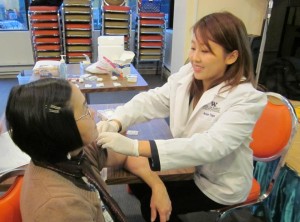In recognition of National Minority Health Month, the Diverse Elders Coalition is featuring stories relevant to the health disparities and health issues affecting diverse older adults during April. A new story will be shared every Wednesday with additional posts shared throughout the month. Be sure to visit diverseelders.org regularly during the month of April.
April is National Minority Health Month. It is a great time to raise awareness of the health disparities that affect racial and ethnic minorities.
In the spirit of raising awareness, here are 10 important things you should know about health disparities among Asian American and Pacific Islander (AAPI) elders including some helpful resources from the National Asian Pacific Center on Aging (NAPCA):
-
- Heart disease, cancer, and stroke are the leading causes of death among AAPIs aged 65 years and older. These account for over 50% of all deaths in this age range.
- AAPIs are at higher risk for Hepatitis B, which can lead to liver cancer. Approximately 1 in 12 AAPIs are living with chronic Hepatitis B, and the death rate from Hepatitis B among AAPIs is 7 times greater than rates among whites.
- Despite having lower body weight, Asian Americans are more likely than whites to have diabetes. Of Asian Americans who develop the disease, more than 95% are diagnosed with type 2 diabetes
- The BMI scale, which is regularly used to determine overweight and obesity, is different for Asian Americans. For Asian Americans a BMI over 24 is the cutoff for overweight, and 27 for obesity; compared to 25 and 30 respectively for the general population
- Mental health is a significant concern in the AAPI older adult population. Numerous studies suggest that Asian American elders have high rates of depression. Additionally, older Asian American women have the highest suicide rate of all women over age 65 in the U.S
- There are health disparities within the AAPI elder population, and some AAPI sub-groups are more at risk for certain diseases and illnesses than others. For example, Japanese and Filipino women have twice as high a risk of getting breast cancer as Korean and Chinese women
- Health beliefs among AAPI elders can be a barrier to health care. For Asian American elders who adhere more to their traditional cultural beliefs, Western biomedical approaches can be perceived as ‘invasive’ or ‘overly aggressive’
- Another major barrier to health care is limited English proficiency. For many AAPI elders that do not speak English well, tasks such as finding a doctor or even understanding symptoms and medications can be incredibly complicated. About 60% of AAPIs aged 65 and older are limited English proficient
- Due to limited resources, elderly AAPIs are more likely to be uninsured or rely on public insurance. Only 33% of Asian Americans aged 65 years and older have private health insurance compared to 52% of the total U.S. population of the same age range.
- NAPCA has resources to help address some of these health disparities among AAPI elders.
-
- Our toll-free Asian language Helpline, which operates in Mandarin, Cantonese, Vietnamese, and Korean, provides information and assistance on Medicare, Social Security, and other senior benefit programs.
- The NAPCA Healthy Aging Resource Center is a searchable database of health information, materials, and resources in 15 Asian languages. These resources have been culled from health centers, community organizations, universities, health departments, etc.
Karen Thurston is a Research Associate for the National Asian Pacific Center on Aging (NAPCA). Karen conducts research on programs, policies, and numerous indicators impacting AAPI older adults and drafts reports and data briefs addressing the needs and conditions of the AAPI elderly population. The opinions expressed in this article are those of the author and do not necessarily reflect those of the Diverse Elders Coalition.


